ACSK4001 Academic Skill Portfolio
VerifiedAdded on 2021/12/14
|14
|4236
|60
AI Summary
Contribute Materials
Your contribution can guide someone’s learning journey. Share your
documents today.
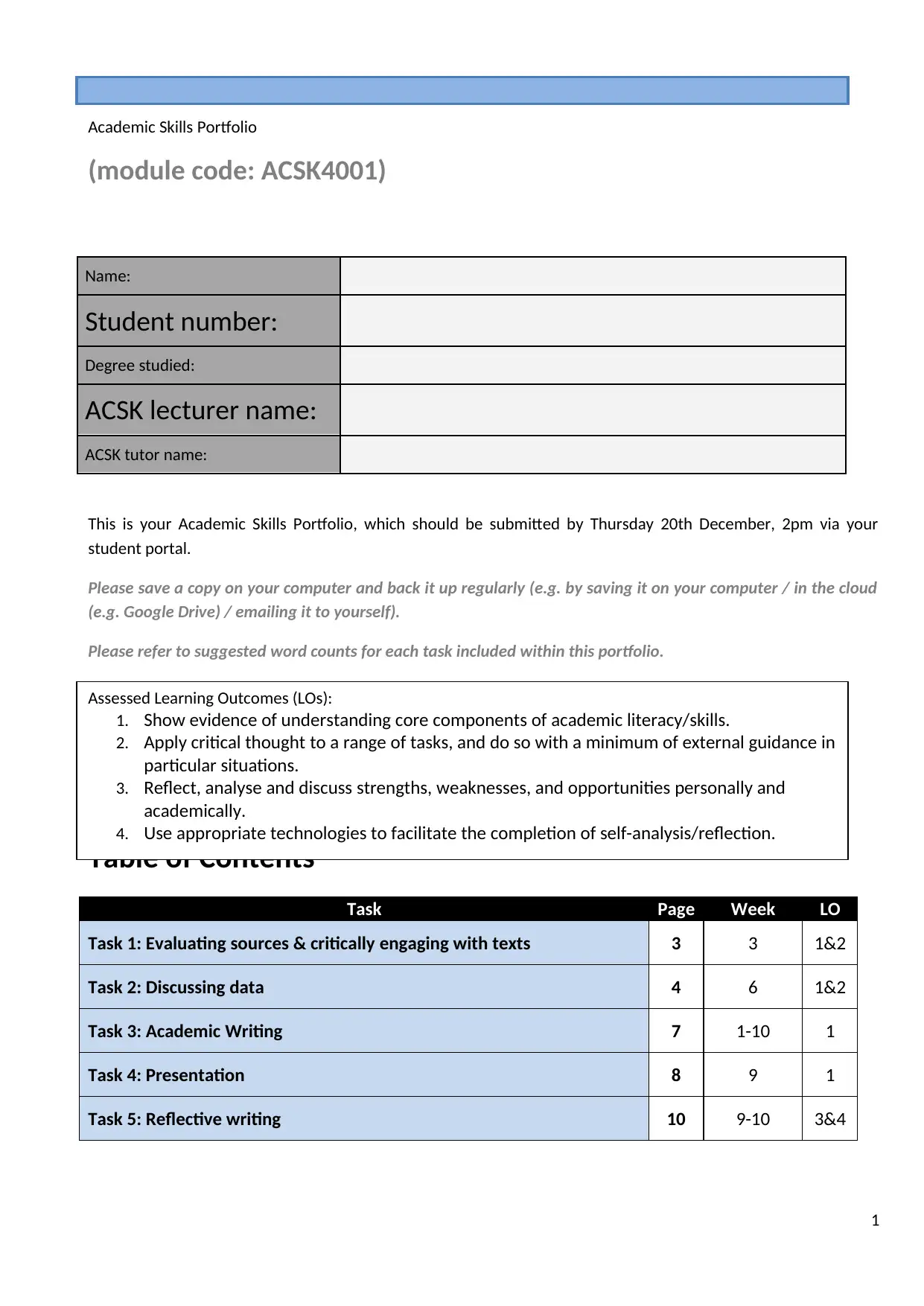
Academic Skills Portfolio
(module code: ACSK4001)
Name:
Student number:
Degree studied:
ACSK lecturer name:
ACSK tutor name:
This is your Academic Skills Portfolio, which should be submitted by Thursday 20th December, 2pm via your
student portal.
Please save a copy on your computer and back it up regularly (e.g. by saving it on your computer / in the cloud
(e.g. Google Drive) / emailing it to yourself).
Please refer to suggested word counts for each task included within this portfolio.
Table of Contents
Task Page Week LO
Task 1: Evaluating sources & critically engaging with texts 3 3 1&2
Task 2: Discussing data 4 6 1&2
Task 3: Academic Writing 7 1-10 1
Task 4: Presentation 8 9 1
Task 5: Reflective writing 10 9-10 3&4
1
Assessed Learning Outcomes (LOs):
1. Show evidence of understanding core components of academic literacy/skills.
2. Apply critical thought to a range of tasks, and do so with a minimum of external guidance in
particular situations.
3. Reflect, analyse and discuss strengths, weaknesses, and opportunities personally and
academically.
4. Use appropriate technologies to facilitate the completion of self-analysis/reflection.
(module code: ACSK4001)
Name:
Student number:
Degree studied:
ACSK lecturer name:
ACSK tutor name:
This is your Academic Skills Portfolio, which should be submitted by Thursday 20th December, 2pm via your
student portal.
Please save a copy on your computer and back it up regularly (e.g. by saving it on your computer / in the cloud
(e.g. Google Drive) / emailing it to yourself).
Please refer to suggested word counts for each task included within this portfolio.
Table of Contents
Task Page Week LO
Task 1: Evaluating sources & critically engaging with texts 3 3 1&2
Task 2: Discussing data 4 6 1&2
Task 3: Academic Writing 7 1-10 1
Task 4: Presentation 8 9 1
Task 5: Reflective writing 10 9-10 3&4
1
Assessed Learning Outcomes (LOs):
1. Show evidence of understanding core components of academic literacy/skills.
2. Apply critical thought to a range of tasks, and do so with a minimum of external guidance in
particular situations.
3. Reflect, analyse and discuss strengths, weaknesses, and opportunities personally and
academically.
4. Use appropriate technologies to facilitate the completion of self-analysis/reflection.
Secure Best Marks with AI Grader
Need help grading? Try our AI Grader for instant feedback on your assignments.
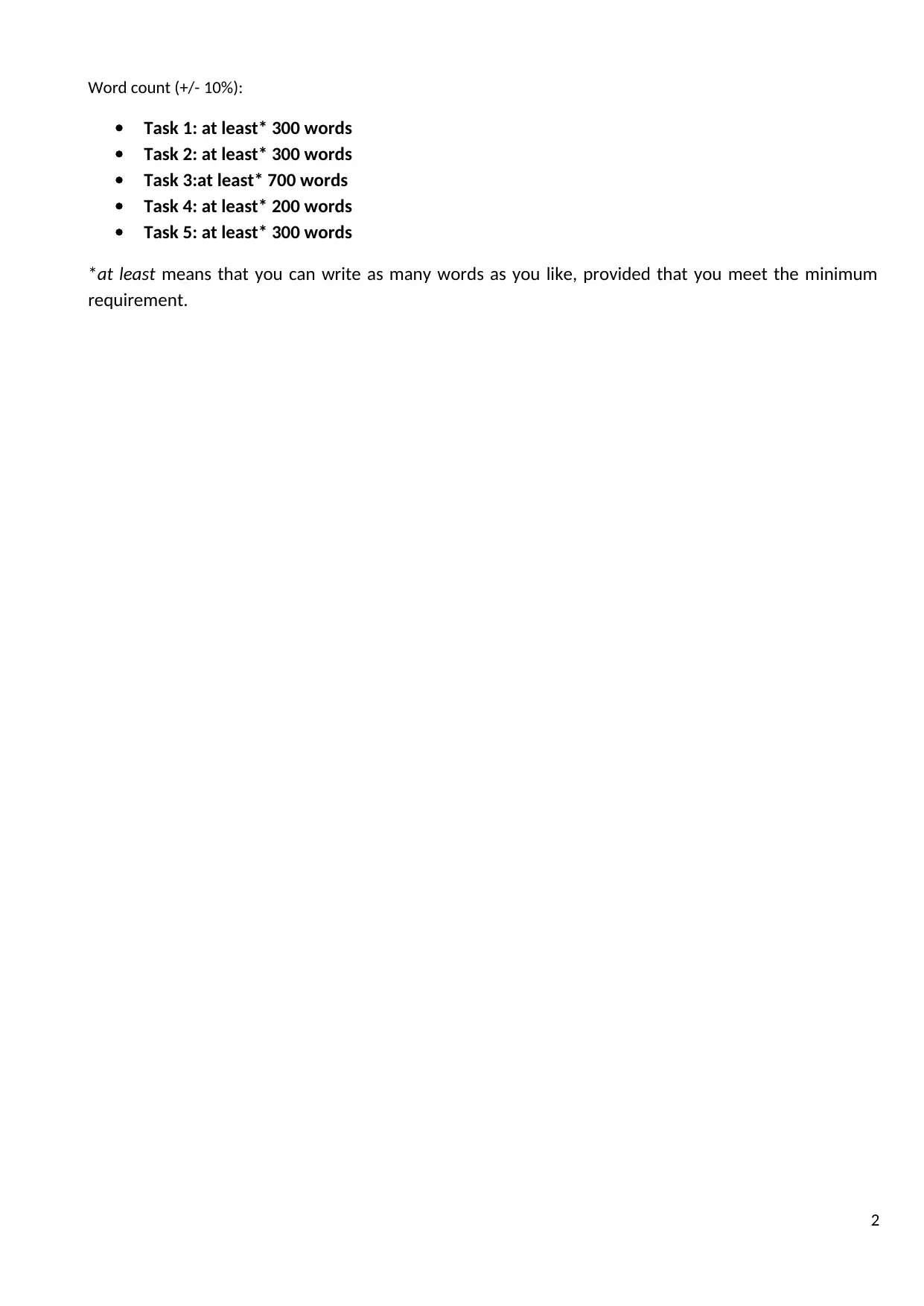
Word count (+/- 10%):
Task 1: at least* 300 words
Task 2: at least* 300 words
Task 3:at least* 700 words
Task 4: at least* 200 words
Task 5: at least* 300 words
*at least means that you can write as many words as you like, provided that you meet the minimum
requirement.
2
Task 1: at least* 300 words
Task 2: at least* 300 words
Task 3:at least* 700 words
Task 4: at least* 200 words
Task 5: at least* 300 words
*at least means that you can write as many words as you like, provided that you meet the minimum
requirement.
2
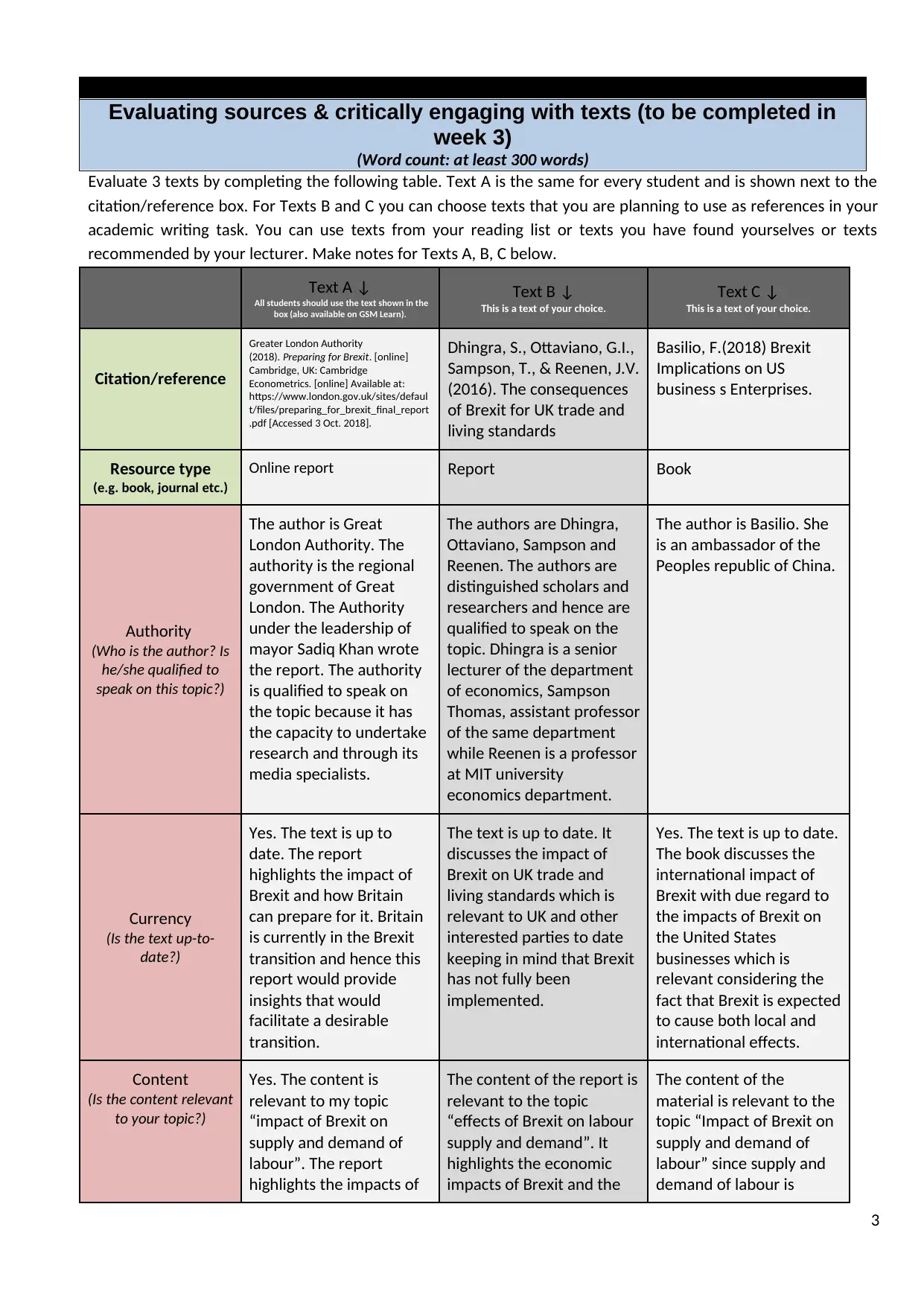
TASK 1
Evaluating sources & critically engaging with texts (to be completed in
week 3)
(Word count: at least 300 words)
Evaluate 3 texts by completing the following table. Text A is the same for every student and is shown next to the
citation/reference box. For Texts B and C you can choose texts that you are planning to use as references in your
academic writing task. You can use texts from your reading list or texts you have found yourselves or texts
recommended by your lecturer. Make notes for Texts A, B, C below.
Text A ↓
All students should use the text shown in the
box (also available on GSM Learn).
Text B ↓
This is a text of your choice.
Text C ↓
This is a text of your choice.
Citation/reference
Greater London Authority
(2018). Preparing for Brexit. [online]
Cambridge, UK: Cambridge
Econometrics. [online] Available at:
https://www.london.gov.uk/sites/defaul
t/files/preparing_for_brexit_final_report
.pdf [Accessed 3 Oct. 2018].
Dhingra, S., Ottaviano, G.I.,
Sampson, T., & Reenen, J.V.
(2016). The consequences
of Brexit for UK trade and
living standards
Basilio, F.(2018) Brexit
Implications on US
business s Enterprises.
Resource type
(e.g. book, journal etc.)
Online report Report Book
Authority
(Who is the author? Is
he/she qualified to
speak on this topic?)
The author is Great
London Authority. The
authority is the regional
government of Great
London. The Authority
under the leadership of
mayor Sadiq Khan wrote
the report. The authority
is qualified to speak on
the topic because it has
the capacity to undertake
research and through its
media specialists.
The authors are Dhingra,
Ottaviano, Sampson and
Reenen. The authors are
distinguished scholars and
researchers and hence are
qualified to speak on the
topic. Dhingra is a senior
lecturer of the department
of economics, Sampson
Thomas, assistant professor
of the same department
while Reenen is a professor
at MIT university
economics department.
The author is Basilio. She
is an ambassador of the
Peoples republic of China.
Currency
(Is the text up-to-
date?)
Yes. The text is up to
date. The report
highlights the impact of
Brexit and how Britain
can prepare for it. Britain
is currently in the Brexit
transition and hence this
report would provide
insights that would
facilitate a desirable
transition.
The text is up to date. It
discusses the impact of
Brexit on UK trade and
living standards which is
relevant to UK and other
interested parties to date
keeping in mind that Brexit
has not fully been
implemented.
Yes. The text is up to date.
The book discusses the
international impact of
Brexit with due regard to
the impacts of Brexit on
the United States
businesses which is
relevant considering the
fact that Brexit is expected
to cause both local and
international effects.
Content
(Is the content relevant
to your topic?)
Yes. The content is
relevant to my topic
“impact of Brexit on
supply and demand of
labour”. The report
highlights the impacts of
The content of the report is
relevant to the topic
“effects of Brexit on labour
supply and demand”. It
highlights the economic
impacts of Brexit and the
The content of the
material is relevant to the
topic “Impact of Brexit on
supply and demand of
labour” since supply and
demand of labour is
3
Evaluating sources & critically engaging with texts (to be completed in
week 3)
(Word count: at least 300 words)
Evaluate 3 texts by completing the following table. Text A is the same for every student and is shown next to the
citation/reference box. For Texts B and C you can choose texts that you are planning to use as references in your
academic writing task. You can use texts from your reading list or texts you have found yourselves or texts
recommended by your lecturer. Make notes for Texts A, B, C below.
Text A ↓
All students should use the text shown in the
box (also available on GSM Learn).
Text B ↓
This is a text of your choice.
Text C ↓
This is a text of your choice.
Citation/reference
Greater London Authority
(2018). Preparing for Brexit. [online]
Cambridge, UK: Cambridge
Econometrics. [online] Available at:
https://www.london.gov.uk/sites/defaul
t/files/preparing_for_brexit_final_report
.pdf [Accessed 3 Oct. 2018].
Dhingra, S., Ottaviano, G.I.,
Sampson, T., & Reenen, J.V.
(2016). The consequences
of Brexit for UK trade and
living standards
Basilio, F.(2018) Brexit
Implications on US
business s Enterprises.
Resource type
(e.g. book, journal etc.)
Online report Report Book
Authority
(Who is the author? Is
he/she qualified to
speak on this topic?)
The author is Great
London Authority. The
authority is the regional
government of Great
London. The Authority
under the leadership of
mayor Sadiq Khan wrote
the report. The authority
is qualified to speak on
the topic because it has
the capacity to undertake
research and through its
media specialists.
The authors are Dhingra,
Ottaviano, Sampson and
Reenen. The authors are
distinguished scholars and
researchers and hence are
qualified to speak on the
topic. Dhingra is a senior
lecturer of the department
of economics, Sampson
Thomas, assistant professor
of the same department
while Reenen is a professor
at MIT university
economics department.
The author is Basilio. She
is an ambassador of the
Peoples republic of China.
Currency
(Is the text up-to-
date?)
Yes. The text is up to
date. The report
highlights the impact of
Brexit and how Britain
can prepare for it. Britain
is currently in the Brexit
transition and hence this
report would provide
insights that would
facilitate a desirable
transition.
The text is up to date. It
discusses the impact of
Brexit on UK trade and
living standards which is
relevant to UK and other
interested parties to date
keeping in mind that Brexit
has not fully been
implemented.
Yes. The text is up to date.
The book discusses the
international impact of
Brexit with due regard to
the impacts of Brexit on
the United States
businesses which is
relevant considering the
fact that Brexit is expected
to cause both local and
international effects.
Content
(Is the content relevant
to your topic?)
Yes. The content is
relevant to my topic
“impact of Brexit on
supply and demand of
labour”. The report
highlights the impacts of
The content of the report is
relevant to the topic
“effects of Brexit on labour
supply and demand”. It
highlights the economic
impacts of Brexit and the
The content of the
material is relevant to the
topic “Impact of Brexit on
supply and demand of
labour” since supply and
demand of labour is
3
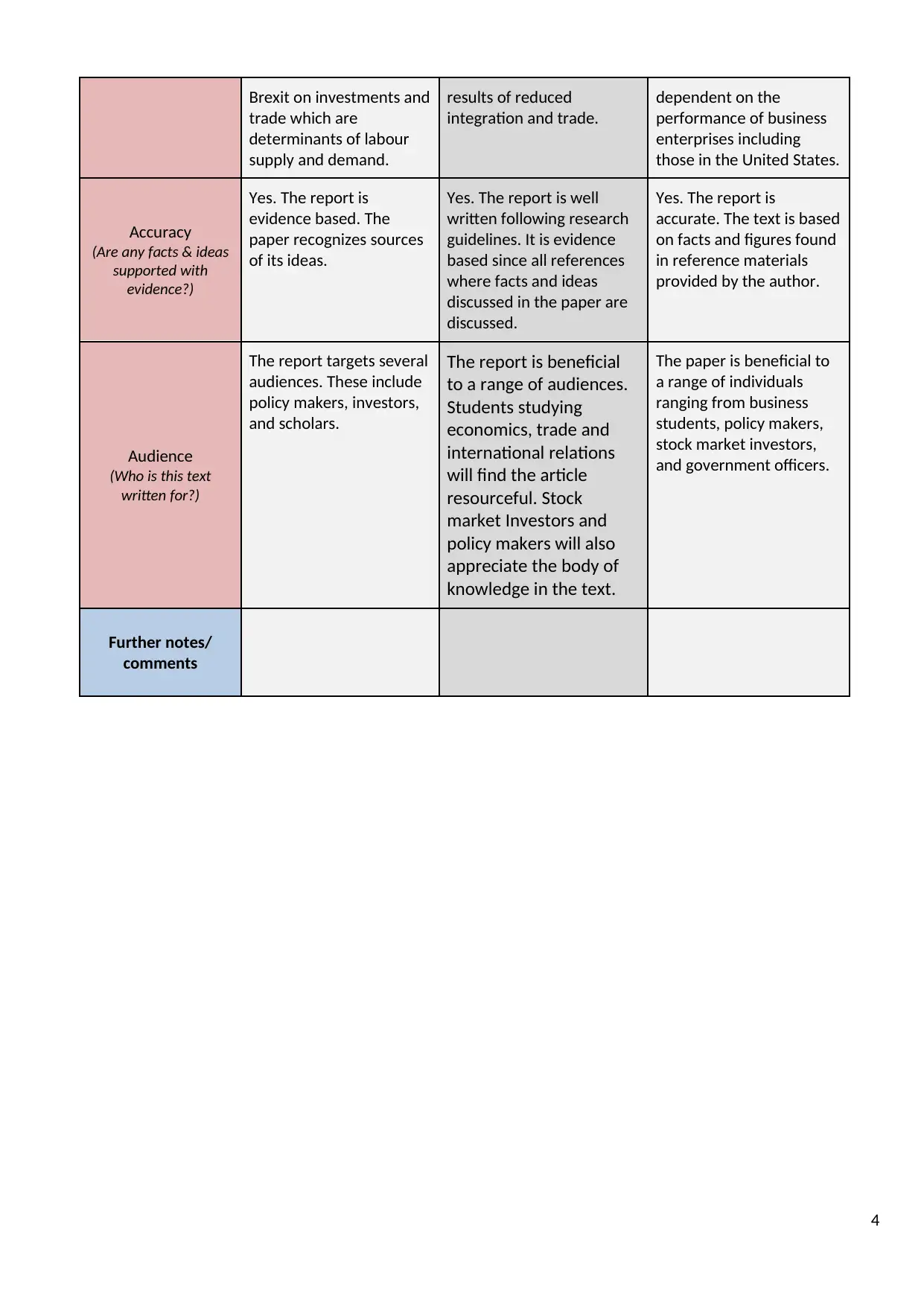
Brexit on investments and
trade which are
determinants of labour
supply and demand.
results of reduced
integration and trade.
dependent on the
performance of business
enterprises including
those in the United States.
Accuracy
(Are any facts & ideas
supported with
evidence?)
Yes. The report is
evidence based. The
paper recognizes sources
of its ideas.
Yes. The report is well
written following research
guidelines. It is evidence
based since all references
where facts and ideas
discussed in the paper are
discussed.
Yes. The report is
accurate. The text is based
on facts and figures found
in reference materials
provided by the author.
Audience
(Who is this text
written for?)
The report targets several
audiences. These include
policy makers, investors,
and scholars.
The report is beneficial
to a range of audiences.
Students studying
economics, trade and
international relations
will find the article
resourceful. Stock
market Investors and
policy makers will also
appreciate the body of
knowledge in the text.
The paper is beneficial to
a range of individuals
ranging from business
students, policy makers,
stock market investors,
and government officers.
Further notes/
comments
4
trade which are
determinants of labour
supply and demand.
results of reduced
integration and trade.
dependent on the
performance of business
enterprises including
those in the United States.
Accuracy
(Are any facts & ideas
supported with
evidence?)
Yes. The report is
evidence based. The
paper recognizes sources
of its ideas.
Yes. The report is well
written following research
guidelines. It is evidence
based since all references
where facts and ideas
discussed in the paper are
discussed.
Yes. The report is
accurate. The text is based
on facts and figures found
in reference materials
provided by the author.
Audience
(Who is this text
written for?)
The report targets several
audiences. These include
policy makers, investors,
and scholars.
The report is beneficial
to a range of audiences.
Students studying
economics, trade and
international relations
will find the article
resourceful. Stock
market Investors and
policy makers will also
appreciate the body of
knowledge in the text.
The paper is beneficial to
a range of individuals
ranging from business
students, policy makers,
stock market investors,
and government officers.
Further notes/
comments
4
Secure Best Marks with AI Grader
Need help grading? Try our AI Grader for instant feedback on your assignments.
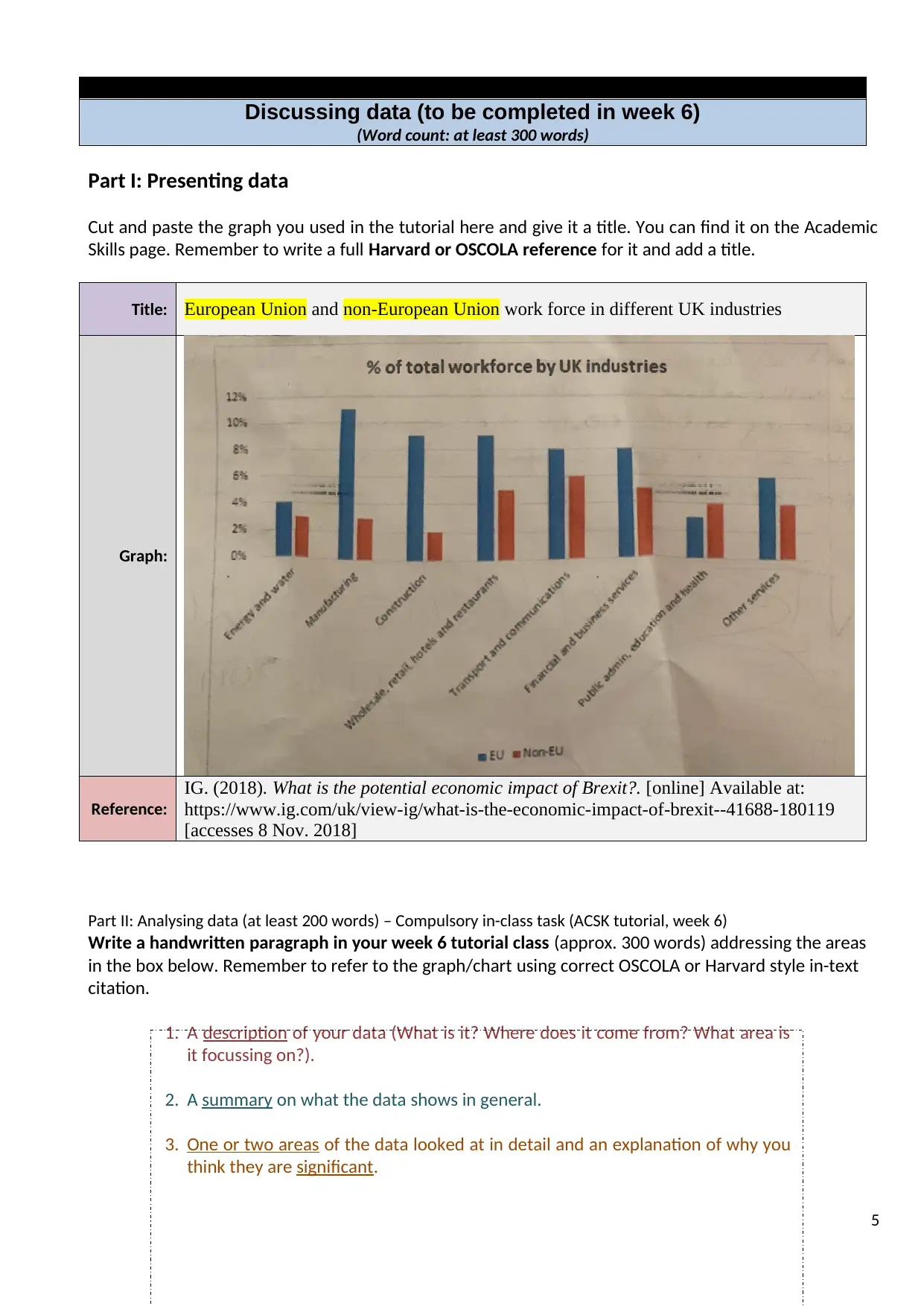
TASK 2
Discussing data (to be completed in week 6)
(Word count: at least 300 words)
Part I: Presenting data
Cut and paste the graph you used in the tutorial here and give it a title. You can find it on the Academic
Skills page. Remember to write a full Harvard or OSCOLA reference for it and add a title.
Title: European Union and non-European Union work force in different UK industries
Graph:
Reference:
IG. (2018). What is the potential economic impact of Brexit?. [online] Available at:
https://www.ig.com/uk/view-ig/what-is-the-economic-impact-of-brexit--41688-180119
[accesses 8 Nov. 2018]
Part II: Analysing data (at least 200 words) – Compulsory in-class task (ACSK tutorial, week 6)
Write a handwritten paragraph in your week 6 tutorial class (approx. 300 words) addressing the areas
in the box below. Remember to refer to the graph/chart using correct OSCOLA or Harvard style in-text
citation.
1. A description of your data (What is it? Where does it come from? What area is
it focussing on?).
2. A summary on what the data shows in general.
3. One or two areas of the data looked at in detail and an explanation of why you
think they are significant.
5
Discussing data (to be completed in week 6)
(Word count: at least 300 words)
Part I: Presenting data
Cut and paste the graph you used in the tutorial here and give it a title. You can find it on the Academic
Skills page. Remember to write a full Harvard or OSCOLA reference for it and add a title.
Title: European Union and non-European Union work force in different UK industries
Graph:
Reference:
IG. (2018). What is the potential economic impact of Brexit?. [online] Available at:
https://www.ig.com/uk/view-ig/what-is-the-economic-impact-of-brexit--41688-180119
[accesses 8 Nov. 2018]
Part II: Analysing data (at least 200 words) – Compulsory in-class task (ACSK tutorial, week 6)
Write a handwritten paragraph in your week 6 tutorial class (approx. 300 words) addressing the areas
in the box below. Remember to refer to the graph/chart using correct OSCOLA or Harvard style in-text
citation.
1. A description of your data (What is it? Where does it come from? What area is
it focussing on?).
2. A summary on what the data shows in general.
3. One or two areas of the data looked at in detail and an explanation of why you
think they are significant.
5
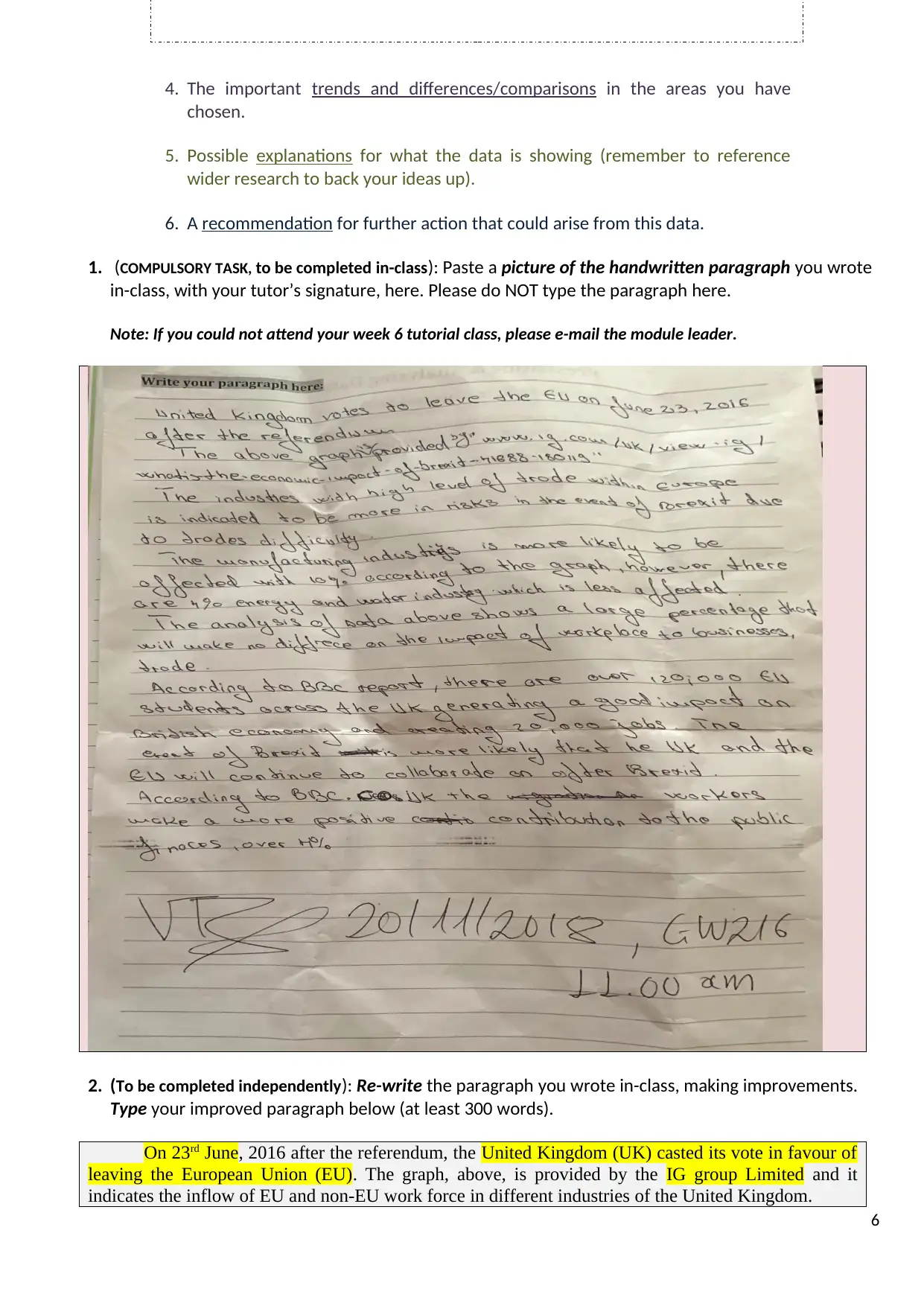
4. The important trends and differences/comparisons in the areas you have
chosen.
5. Possible explanations for what the data is showing (remember to reference
wider research to back your ideas up).
6. A recommendation for further action that could arise from this data.
1. (COMPULSORY TASK, to be completed in-class): Paste a picture of the handwritten paragraph you wrote
in-class, with your tutor’s signature, here. Please do NOT type the paragraph here.
Note: If you could not attend your week 6 tutorial class, please e-mail the module leader.
2. (To be completed independently): Re-write the paragraph you wrote in-class, making improvements.
Type your improved paragraph below (at least 300 words).
On 23rd June, 2016 after the referendum, the United Kingdom (UK) casted its vote in favour of
leaving the European Union (EU). The graph, above, is provided by the IG group Limited and it
indicates the inflow of EU and non-EU work force in different industries of the United Kingdom.
6
chosen.
5. Possible explanations for what the data is showing (remember to reference
wider research to back your ideas up).
6. A recommendation for further action that could arise from this data.
1. (COMPULSORY TASK, to be completed in-class): Paste a picture of the handwritten paragraph you wrote
in-class, with your tutor’s signature, here. Please do NOT type the paragraph here.
Note: If you could not attend your week 6 tutorial class, please e-mail the module leader.
2. (To be completed independently): Re-write the paragraph you wrote in-class, making improvements.
Type your improved paragraph below (at least 300 words).
On 23rd June, 2016 after the referendum, the United Kingdom (UK) casted its vote in favour of
leaving the European Union (EU). The graph, above, is provided by the IG group Limited and it
indicates the inflow of EU and non-EU work force in different industries of the United Kingdom.
6
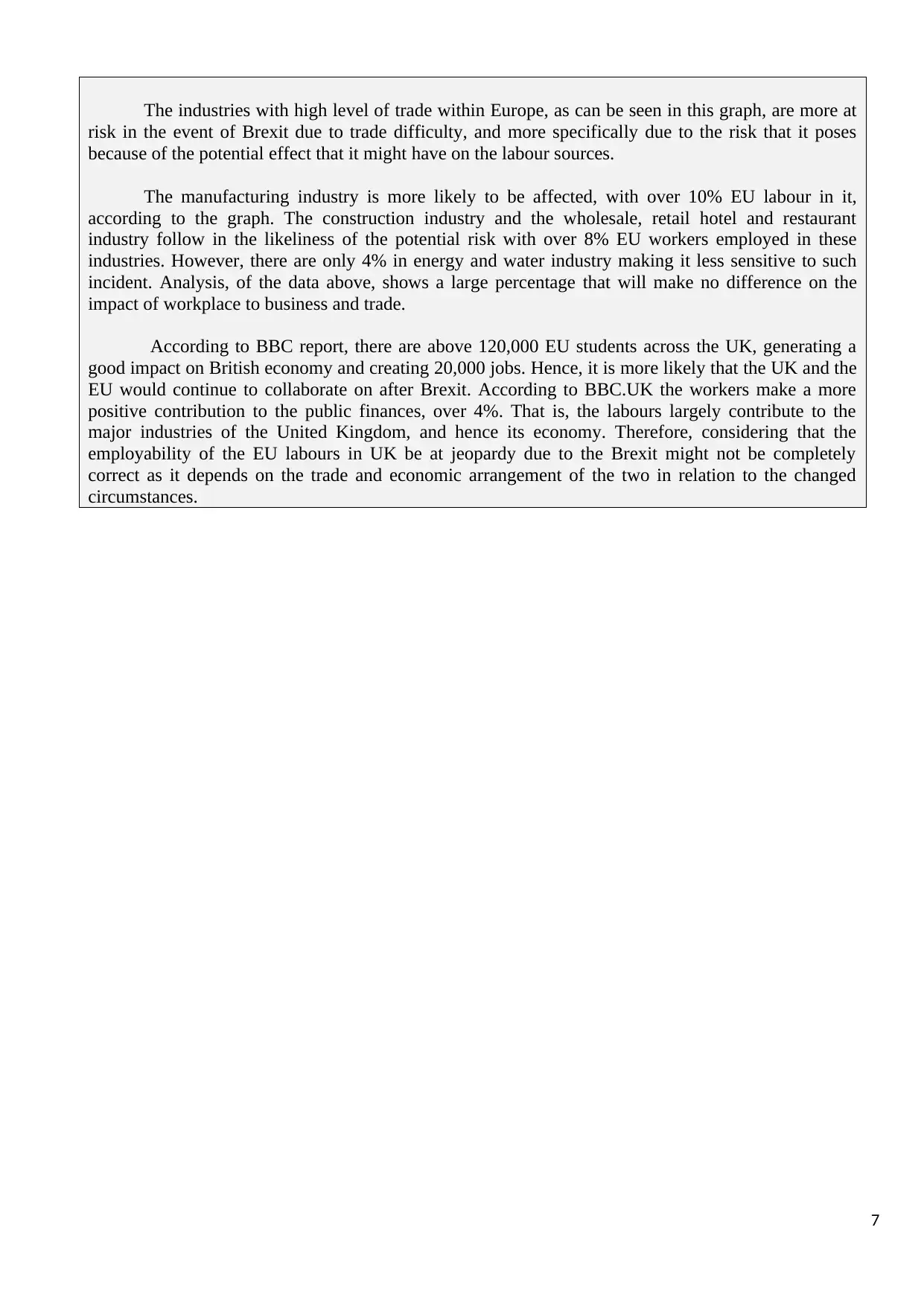
The industries with high level of trade within Europe, as can be seen in this graph, are more at
risk in the event of Brexit due to trade difficulty, and more specifically due to the risk that it poses
because of the potential effect that it might have on the labour sources.
The manufacturing industry is more likely to be affected, with over 10% EU labour in it,
according to the graph. The construction industry and the wholesale, retail hotel and restaurant
industry follow in the likeliness of the potential risk with over 8% EU workers employed in these
industries. However, there are only 4% in energy and water industry making it less sensitive to such
incident. Analysis, of the data above, shows a large percentage that will make no difference on the
impact of workplace to business and trade.
According to BBC report, there are above 120,000 EU students across the UK, generating a
good impact on British economy and creating 20,000 jobs. Hence, it is more likely that the UK and the
EU would continue to collaborate on after Brexit. According to BBC.UK the workers make a more
positive contribution to the public finances, over 4%. That is, the labours largely contribute to the
major industries of the United Kingdom, and hence its economy. Therefore, considering that the
employability of the EU labours in UK be at jeopardy due to the Brexit might not be completely
correct as it depends on the trade and economic arrangement of the two in relation to the changed
circumstances.
7
risk in the event of Brexit due to trade difficulty, and more specifically due to the risk that it poses
because of the potential effect that it might have on the labour sources.
The manufacturing industry is more likely to be affected, with over 10% EU labour in it,
according to the graph. The construction industry and the wholesale, retail hotel and restaurant
industry follow in the likeliness of the potential risk with over 8% EU workers employed in these
industries. However, there are only 4% in energy and water industry making it less sensitive to such
incident. Analysis, of the data above, shows a large percentage that will make no difference on the
impact of workplace to business and trade.
According to BBC report, there are above 120,000 EU students across the UK, generating a
good impact on British economy and creating 20,000 jobs. Hence, it is more likely that the UK and the
EU would continue to collaborate on after Brexit. According to BBC.UK the workers make a more
positive contribution to the public finances, over 4%. That is, the labours largely contribute to the
major industries of the United Kingdom, and hence its economy. Therefore, considering that the
employability of the EU labours in UK be at jeopardy due to the Brexit might not be completely
correct as it depends on the trade and economic arrangement of the two in relation to the changed
circumstances.
7
Paraphrase This Document
Need a fresh take? Get an instant paraphrase of this document with our AI Paraphraser
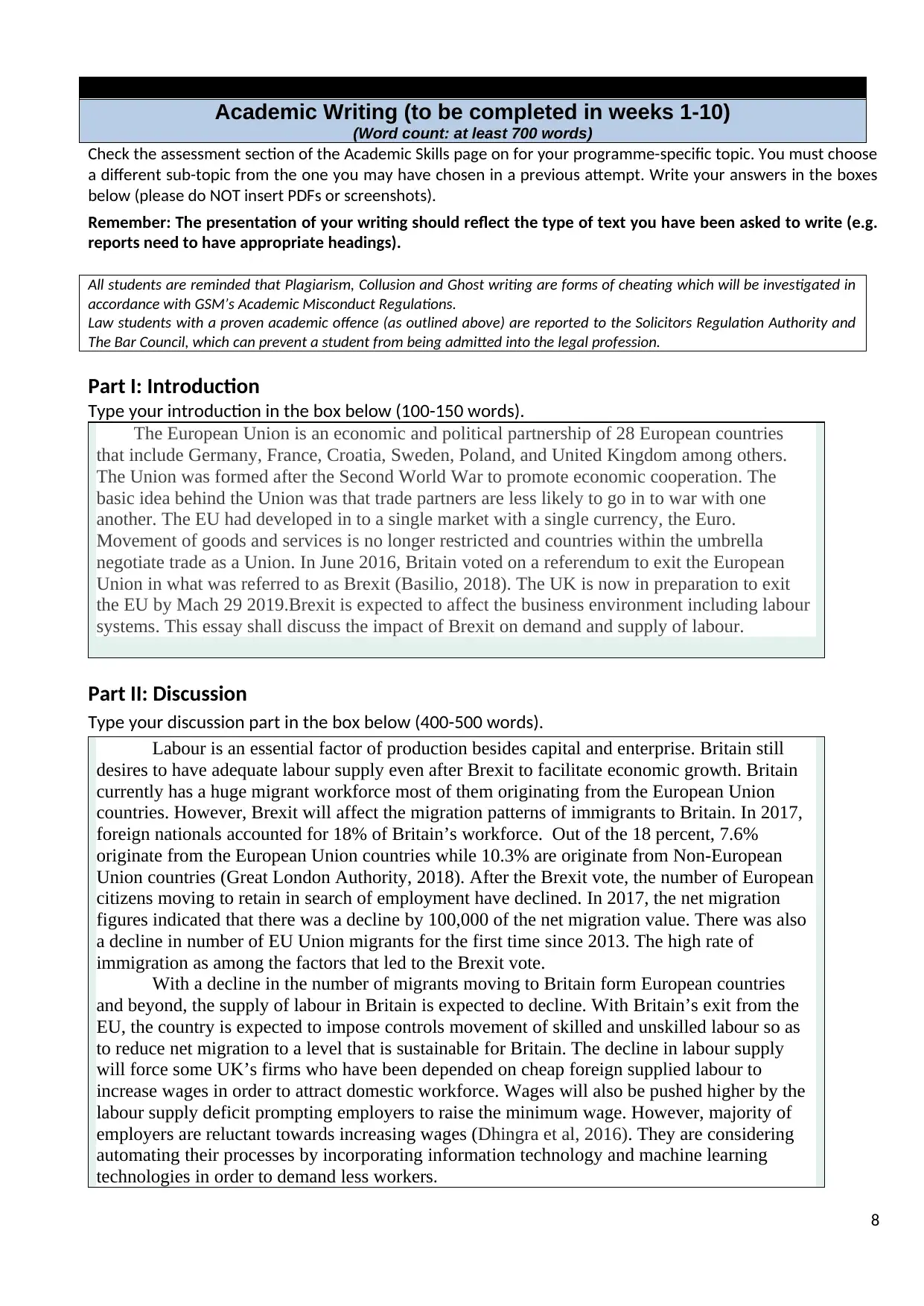
TASK 3
Academic Writing (to be completed in weeks 1-10)
(Word count: at least 700 words)
Check the assessment section of the Academic Skills page on for your programme-specific topic. You must choose
a different sub-topic from the one you may have chosen in a previous attempt. Write your answers in the boxes
below (please do NOT insert PDFs or screenshots).
Remember: The presentation of your writing should reflect the type of text you have been asked to write (e.g.
reports need to have appropriate headings).
All students are reminded that Plagiarism, Collusion and Ghost writing are forms of cheating which will be investigated in
accordance with GSM’s Academic Misconduct Regulations.
Law students with a proven academic offence (as outlined above) are reported to the Solicitors Regulation Authority and
The Bar Council, which can prevent a student from being admitted into the legal profession.
Part I: Introduction
Type your introduction in the box below (100-150 words).
The European Union is an economic and political partnership of 28 European countries
that include Germany, France, Croatia, Sweden, Poland, and United Kingdom among others.
The Union was formed after the Second World War to promote economic cooperation. The
basic idea behind the Union was that trade partners are less likely to go in to war with one
another. The EU had developed in to a single market with a single currency, the Euro.
Movement of goods and services is no longer restricted and countries within the umbrella
negotiate trade as a Union. In June 2016, Britain voted on a referendum to exit the European
Union in what was referred to as Brexit (Basilio, 2018). The UK is now in preparation to exit
the EU by Mach 29 2019.Brexit is expected to affect the business environment including labour
systems. This essay shall discuss the impact of Brexit on demand and supply of labour.
Part II: Discussion
Type your discussion part in the box below (400-500 words).
Labour is an essential factor of production besides capital and enterprise. Britain still
desires to have adequate labour supply even after Brexit to facilitate economic growth. Britain
currently has a huge migrant workforce most of them originating from the European Union
countries. However, Brexit will affect the migration patterns of immigrants to Britain. In 2017,
foreign nationals accounted for 18% of Britain’s workforce. Out of the 18 percent, 7.6%
originate from the European Union countries while 10.3% are originate from Non-European
Union countries (Great London Authority, 2018). After the Brexit vote, the number of European
citizens moving to retain in search of employment have declined. In 2017, the net migration
figures indicated that there was a decline by 100,000 of the net migration value. There was also
a decline in number of EU Union migrants for the first time since 2013. The high rate of
immigration as among the factors that led to the Brexit vote.
With a decline in the number of migrants moving to Britain form European countries
and beyond, the supply of labour in Britain is expected to decline. With Britain’s exit from the
EU, the country is expected to impose controls movement of skilled and unskilled labour so as
to reduce net migration to a level that is sustainable for Britain. The decline in labour supply
will force some UK’s firms who have been depended on cheap foreign supplied labour to
increase wages in order to attract domestic workforce. Wages will also be pushed higher by the
labour supply deficit prompting employers to raise the minimum wage. However, majority of
employers are reluctant towards increasing wages (Dhingra et al, 2016). They are considering
automating their processes by incorporating information technology and machine learning
technologies in order to demand less workers.
8
Academic Writing (to be completed in weeks 1-10)
(Word count: at least 700 words)
Check the assessment section of the Academic Skills page on for your programme-specific topic. You must choose
a different sub-topic from the one you may have chosen in a previous attempt. Write your answers in the boxes
below (please do NOT insert PDFs or screenshots).
Remember: The presentation of your writing should reflect the type of text you have been asked to write (e.g.
reports need to have appropriate headings).
All students are reminded that Plagiarism, Collusion and Ghost writing are forms of cheating which will be investigated in
accordance with GSM’s Academic Misconduct Regulations.
Law students with a proven academic offence (as outlined above) are reported to the Solicitors Regulation Authority and
The Bar Council, which can prevent a student from being admitted into the legal profession.
Part I: Introduction
Type your introduction in the box below (100-150 words).
The European Union is an economic and political partnership of 28 European countries
that include Germany, France, Croatia, Sweden, Poland, and United Kingdom among others.
The Union was formed after the Second World War to promote economic cooperation. The
basic idea behind the Union was that trade partners are less likely to go in to war with one
another. The EU had developed in to a single market with a single currency, the Euro.
Movement of goods and services is no longer restricted and countries within the umbrella
negotiate trade as a Union. In June 2016, Britain voted on a referendum to exit the European
Union in what was referred to as Brexit (Basilio, 2018). The UK is now in preparation to exit
the EU by Mach 29 2019.Brexit is expected to affect the business environment including labour
systems. This essay shall discuss the impact of Brexit on demand and supply of labour.
Part II: Discussion
Type your discussion part in the box below (400-500 words).
Labour is an essential factor of production besides capital and enterprise. Britain still
desires to have adequate labour supply even after Brexit to facilitate economic growth. Britain
currently has a huge migrant workforce most of them originating from the European Union
countries. However, Brexit will affect the migration patterns of immigrants to Britain. In 2017,
foreign nationals accounted for 18% of Britain’s workforce. Out of the 18 percent, 7.6%
originate from the European Union countries while 10.3% are originate from Non-European
Union countries (Great London Authority, 2018). After the Brexit vote, the number of European
citizens moving to retain in search of employment have declined. In 2017, the net migration
figures indicated that there was a decline by 100,000 of the net migration value. There was also
a decline in number of EU Union migrants for the first time since 2013. The high rate of
immigration as among the factors that led to the Brexit vote.
With a decline in the number of migrants moving to Britain form European countries
and beyond, the supply of labour in Britain is expected to decline. With Britain’s exit from the
EU, the country is expected to impose controls movement of skilled and unskilled labour so as
to reduce net migration to a level that is sustainable for Britain. The decline in labour supply
will force some UK’s firms who have been depended on cheap foreign supplied labour to
increase wages in order to attract domestic workforce. Wages will also be pushed higher by the
labour supply deficit prompting employers to raise the minimum wage. However, majority of
employers are reluctant towards increasing wages (Dhingra et al, 2016). They are considering
automating their processes by incorporating information technology and machine learning
technologies in order to demand less workers.
8
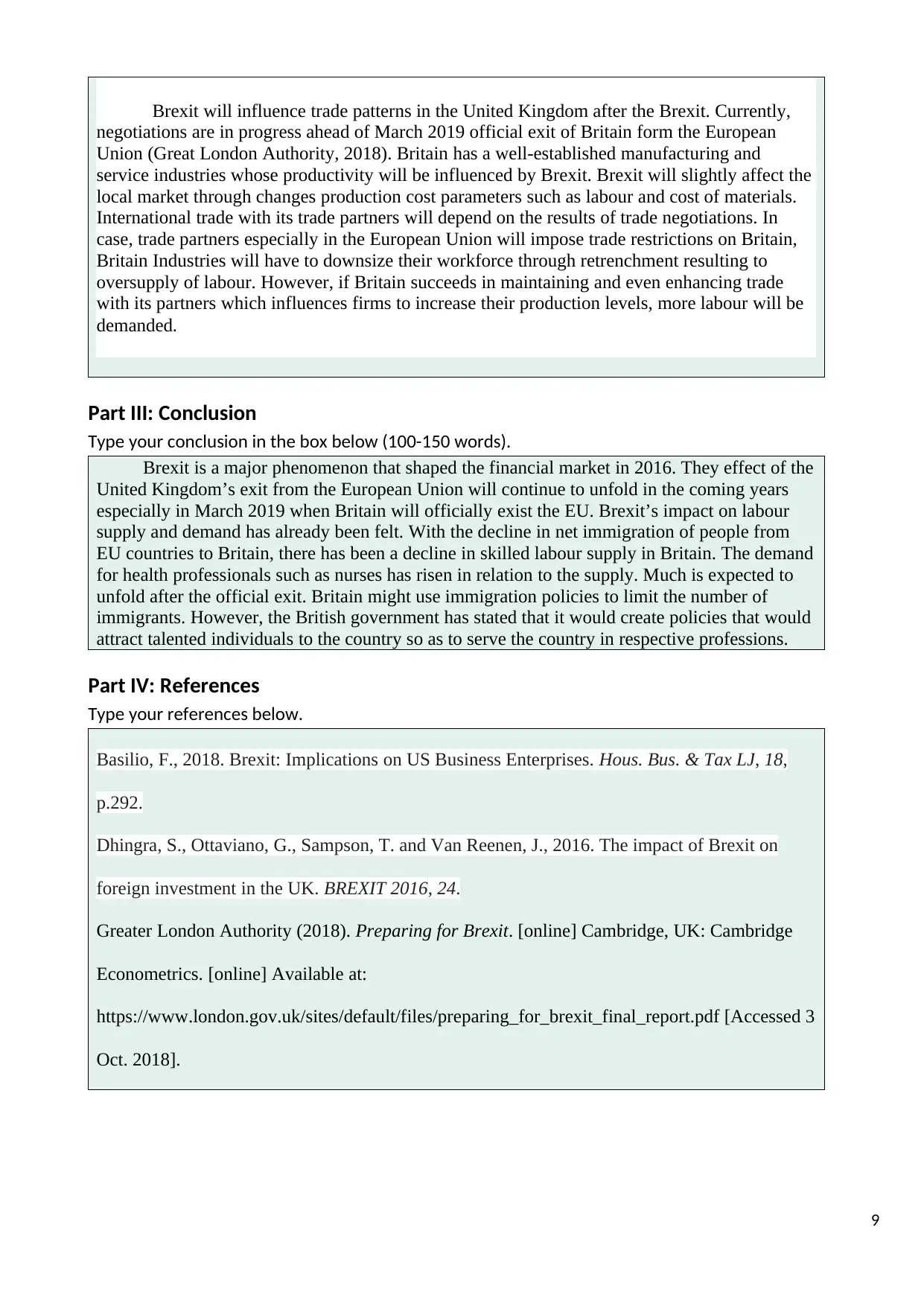
Brexit will influence trade patterns in the United Kingdom after the Brexit. Currently,
negotiations are in progress ahead of March 2019 official exit of Britain form the European
Union (Great London Authority, 2018). Britain has a well-established manufacturing and
service industries whose productivity will be influenced by Brexit. Brexit will slightly affect the
local market through changes production cost parameters such as labour and cost of materials.
International trade with its trade partners will depend on the results of trade negotiations. In
case, trade partners especially in the European Union will impose trade restrictions on Britain,
Britain Industries will have to downsize their workforce through retrenchment resulting to
oversupply of labour. However, if Britain succeeds in maintaining and even enhancing trade
with its partners which influences firms to increase their production levels, more labour will be
demanded.
Part III: Conclusion
Type your conclusion in the box below (100-150 words).
Brexit is a major phenomenon that shaped the financial market in 2016. They effect of the
United Kingdom’s exit from the European Union will continue to unfold in the coming years
especially in March 2019 when Britain will officially exist the EU. Brexit’s impact on labour
supply and demand has already been felt. With the decline in net immigration of people from
EU countries to Britain, there has been a decline in skilled labour supply in Britain. The demand
for health professionals such as nurses has risen in relation to the supply. Much is expected to
unfold after the official exit. Britain might use immigration policies to limit the number of
immigrants. However, the British government has stated that it would create policies that would
attract talented individuals to the country so as to serve the country in respective professions.
Part IV: References
Type your references below.
Basilio, F., 2018. Brexit: Implications on US Business Enterprises. Hous. Bus. & Tax LJ, 18,
p.292.
Dhingra, S., Ottaviano, G., Sampson, T. and Van Reenen, J., 2016. The impact of Brexit on
foreign investment in the UK. BREXIT 2016, 24.
Greater London Authority (2018). Preparing for Brexit. [online] Cambridge, UK: Cambridge
Econometrics. [online] Available at:
https://www.london.gov.uk/sites/default/files/preparing_for_brexit_final_report.pdf [Accessed 3
Oct. 2018].
9
negotiations are in progress ahead of March 2019 official exit of Britain form the European
Union (Great London Authority, 2018). Britain has a well-established manufacturing and
service industries whose productivity will be influenced by Brexit. Brexit will slightly affect the
local market through changes production cost parameters such as labour and cost of materials.
International trade with its trade partners will depend on the results of trade negotiations. In
case, trade partners especially in the European Union will impose trade restrictions on Britain,
Britain Industries will have to downsize their workforce through retrenchment resulting to
oversupply of labour. However, if Britain succeeds in maintaining and even enhancing trade
with its partners which influences firms to increase their production levels, more labour will be
demanded.
Part III: Conclusion
Type your conclusion in the box below (100-150 words).
Brexit is a major phenomenon that shaped the financial market in 2016. They effect of the
United Kingdom’s exit from the European Union will continue to unfold in the coming years
especially in March 2019 when Britain will officially exist the EU. Brexit’s impact on labour
supply and demand has already been felt. With the decline in net immigration of people from
EU countries to Britain, there has been a decline in skilled labour supply in Britain. The demand
for health professionals such as nurses has risen in relation to the supply. Much is expected to
unfold after the official exit. Britain might use immigration policies to limit the number of
immigrants. However, the British government has stated that it would create policies that would
attract talented individuals to the country so as to serve the country in respective professions.
Part IV: References
Type your references below.
Basilio, F., 2018. Brexit: Implications on US Business Enterprises. Hous. Bus. & Tax LJ, 18,
p.292.
Dhingra, S., Ottaviano, G., Sampson, T. and Van Reenen, J., 2016. The impact of Brexit on
foreign investment in the UK. BREXIT 2016, 24.
Greater London Authority (2018). Preparing for Brexit. [online] Cambridge, UK: Cambridge
Econometrics. [online] Available at:
https://www.london.gov.uk/sites/default/files/preparing_for_brexit_final_report.pdf [Accessed 3
Oct. 2018].
9
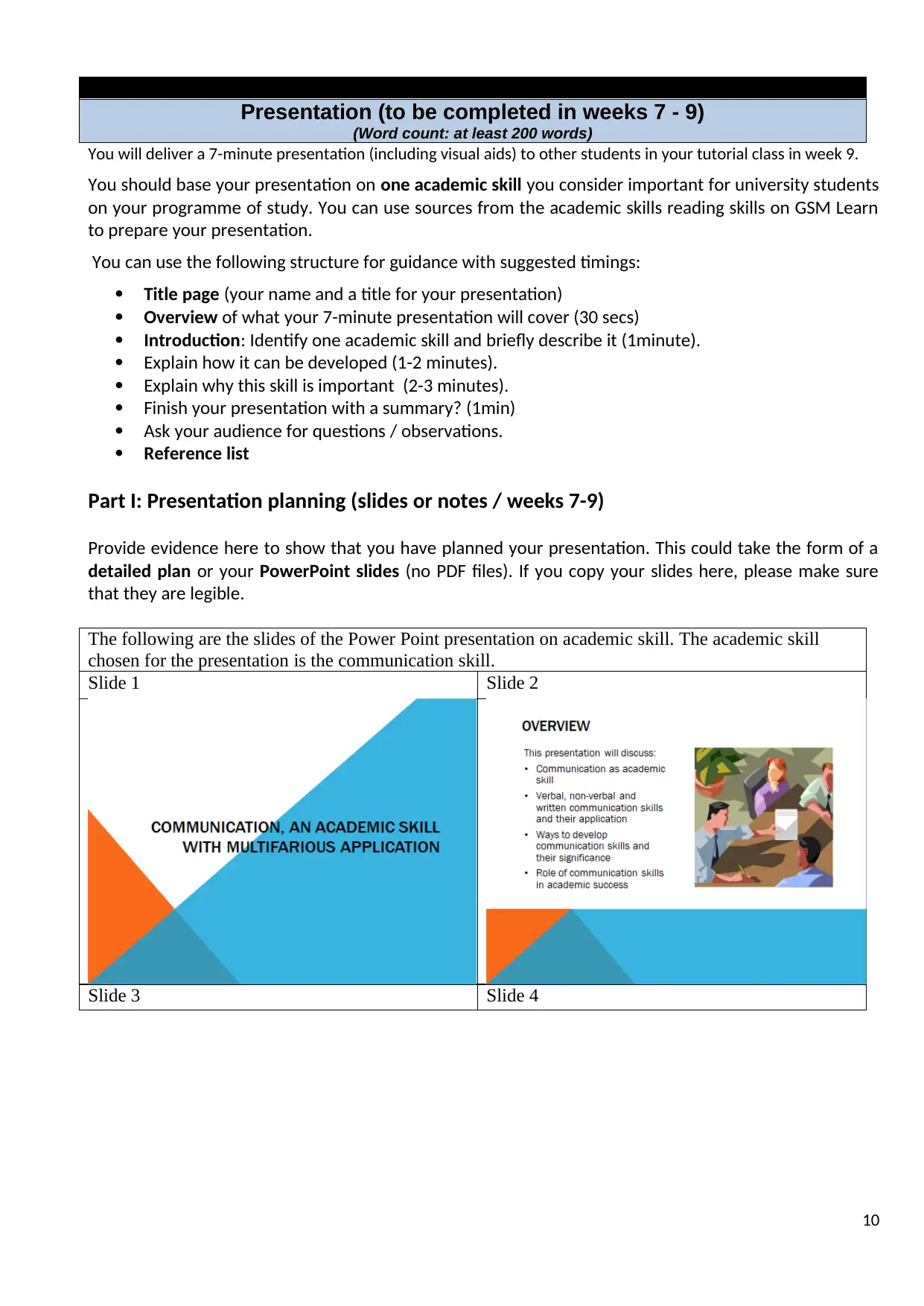
TASK 4
Presentation (to be completed in weeks 7 - 9)
(Word count: at least 200 words)
You will deliver a 7-minute presentation (including visual aids) to other students in your tutorial class in week 9.
You should base your presentation on one academic skill you consider important for university students
on your programme of study. You can use sources from the academic skills reading skills on GSM Learn
to prepare your presentation.
You can use the following structure for guidance with suggested timings:
Title page (your name and a title for your presentation)
Overview of what your 7-minute presentation will cover (30 secs)
Introduction: Identify one academic skill and briefly describe it (1minute).
Explain how it can be developed (1-2 minutes).
Explain why this skill is important (2-3 minutes).
Finish your presentation with a summary? (1min)
Ask your audience for questions / observations.
Reference list
Part I: Presentation planning (slides or notes / weeks 7-9)
Provide evidence here to show that you have planned your presentation. This could take the form of a
detailed plan or your PowerPoint slides (no PDF files). If you copy your slides here, please make sure
that they are legible.
The following are the slides of the Power Point presentation on academic skill. The academic skill
chosen for the presentation is the communication skill.
Slide 1 Slide 2
Slide 3 Slide 4
10
Presentation (to be completed in weeks 7 - 9)
(Word count: at least 200 words)
You will deliver a 7-minute presentation (including visual aids) to other students in your tutorial class in week 9.
You should base your presentation on one academic skill you consider important for university students
on your programme of study. You can use sources from the academic skills reading skills on GSM Learn
to prepare your presentation.
You can use the following structure for guidance with suggested timings:
Title page (your name and a title for your presentation)
Overview of what your 7-minute presentation will cover (30 secs)
Introduction: Identify one academic skill and briefly describe it (1minute).
Explain how it can be developed (1-2 minutes).
Explain why this skill is important (2-3 minutes).
Finish your presentation with a summary? (1min)
Ask your audience for questions / observations.
Reference list
Part I: Presentation planning (slides or notes / weeks 7-9)
Provide evidence here to show that you have planned your presentation. This could take the form of a
detailed plan or your PowerPoint slides (no PDF files). If you copy your slides here, please make sure
that they are legible.
The following are the slides of the Power Point presentation on academic skill. The academic skill
chosen for the presentation is the communication skill.
Slide 1 Slide 2
Slide 3 Slide 4
10
Secure Best Marks with AI Grader
Need help grading? Try our AI Grader for instant feedback on your assignments.
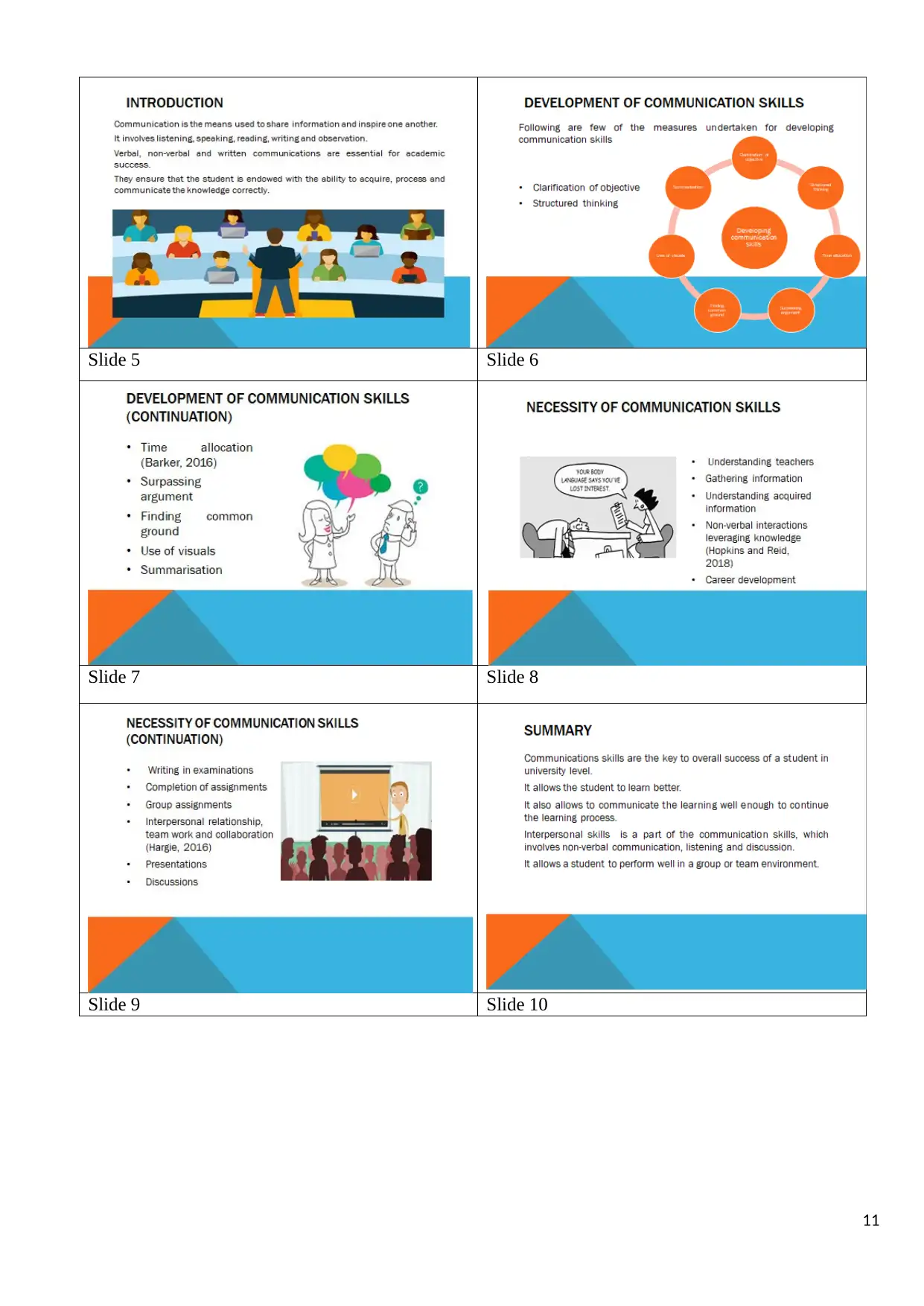
Slide 5 Slide 6
Slide 7 Slide 8
Slide 9 Slide 10
11
Slide 7 Slide 8
Slide 9 Slide 10
11
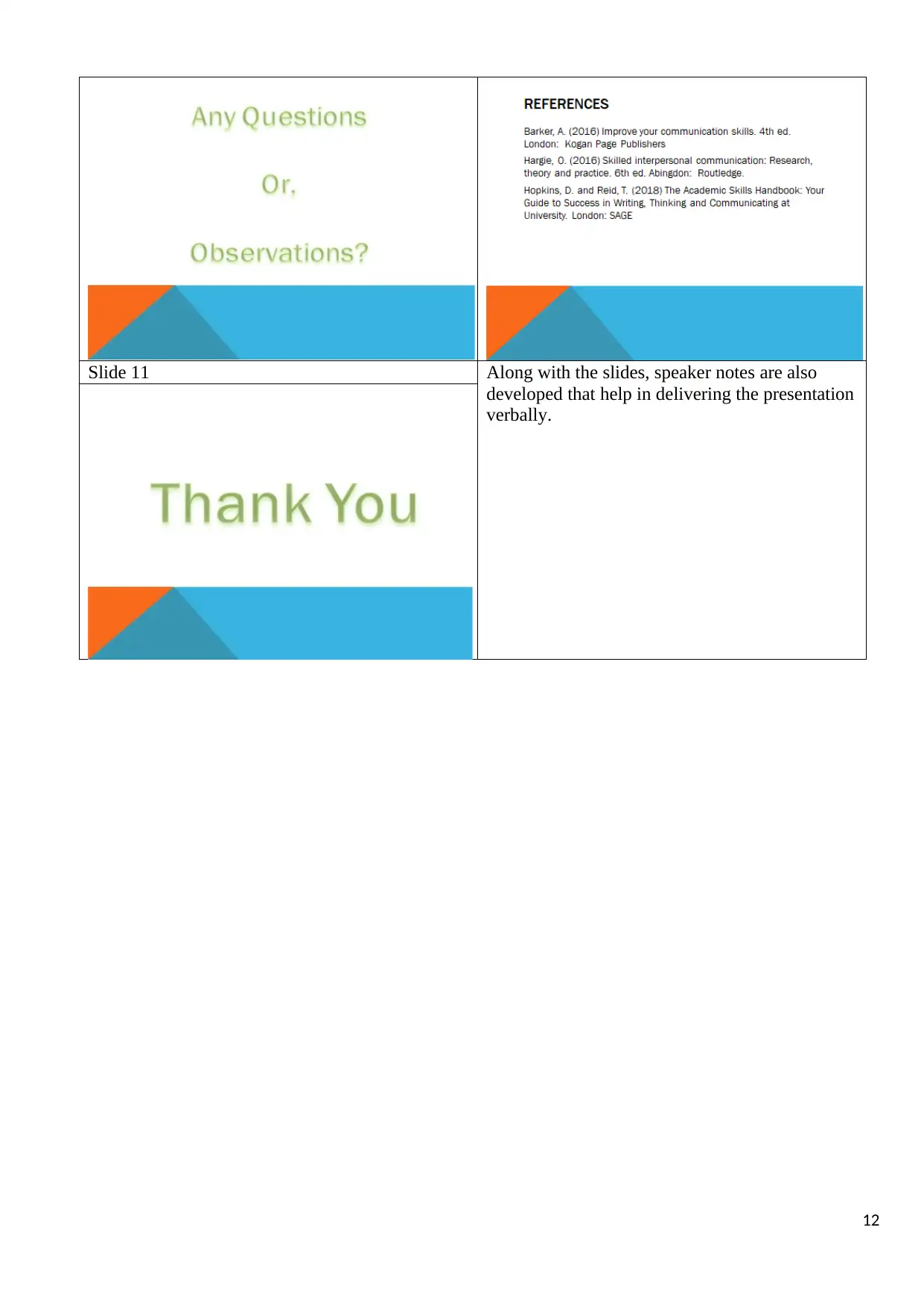
Slide 11 Along with the slides, speaker notes are also
developed that help in delivering the presentation
verbally.
12
developed that help in delivering the presentation
verbally.
12
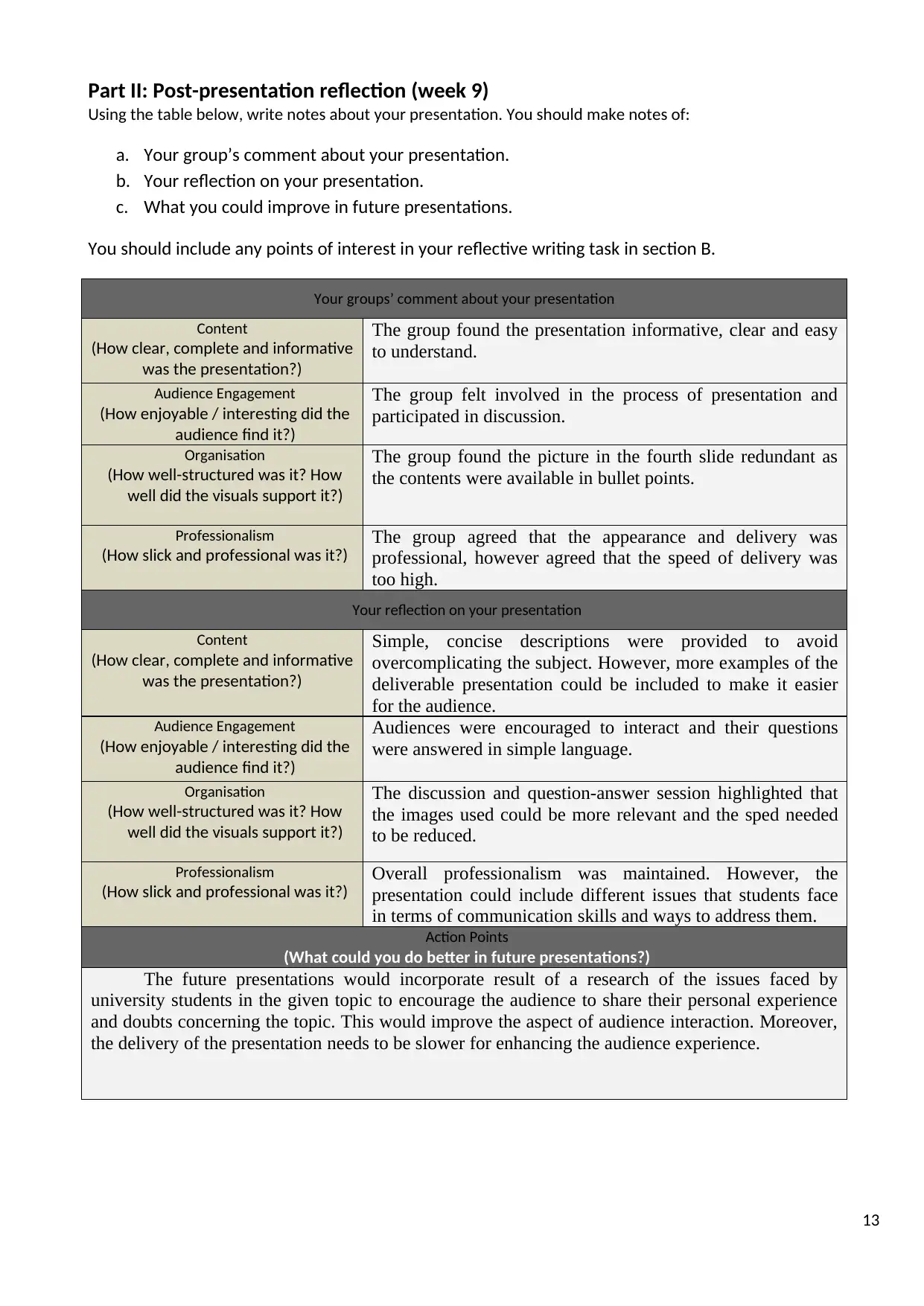
Part II: Post-presentation reflection (week 9)
Using the table below, write notes about your presentation. You should make notes of:
a. Your group’s comment about your presentation.
b. Your reflection on your presentation.
c. What you could improve in future presentations.
You should include any points of interest in your reflective writing task in section B.
Your groups’ comment about your presentation
Content
(How clear, complete and informative
was the presentation?)
The group found the presentation informative, clear and easy
to understand.
Audience Engagement
(How enjoyable / interesting did the
audience find it?)
The group felt involved in the process of presentation and
participated in discussion.
Organisation
(How well-structured was it? How
well did the visuals support it?)
The group found the picture in the fourth slide redundant as
the contents were available in bullet points.
Professionalism
(How slick and professional was it?)
The group agreed that the appearance and delivery was
professional, however agreed that the speed of delivery was
too high.
Your reflection on your presentation
Content
(How clear, complete and informative
was the presentation?)
Simple, concise descriptions were provided to avoid
overcomplicating the subject. However, more examples of the
deliverable presentation could be included to make it easier
for the audience.
Audience Engagement
(How enjoyable / interesting did the
audience find it?)
Audiences were encouraged to interact and their questions
were answered in simple language.
Organisation
(How well-structured was it? How
well did the visuals support it?)
The discussion and question-answer session highlighted that
the images used could be more relevant and the sped needed
to be reduced.
Professionalism
(How slick and professional was it?)
Overall professionalism was maintained. However, the
presentation could include different issues that students face
in terms of communication skills and ways to address them.
Action Points
(What could you do better in future presentations?)
The future presentations would incorporate result of a research of the issues faced by
university students in the given topic to encourage the audience to share their personal experience
and doubts concerning the topic. This would improve the aspect of audience interaction. Moreover,
the delivery of the presentation needs to be slower for enhancing the audience experience.
13
Using the table below, write notes about your presentation. You should make notes of:
a. Your group’s comment about your presentation.
b. Your reflection on your presentation.
c. What you could improve in future presentations.
You should include any points of interest in your reflective writing task in section B.
Your groups’ comment about your presentation
Content
(How clear, complete and informative
was the presentation?)
The group found the presentation informative, clear and easy
to understand.
Audience Engagement
(How enjoyable / interesting did the
audience find it?)
The group felt involved in the process of presentation and
participated in discussion.
Organisation
(How well-structured was it? How
well did the visuals support it?)
The group found the picture in the fourth slide redundant as
the contents were available in bullet points.
Professionalism
(How slick and professional was it?)
The group agreed that the appearance and delivery was
professional, however agreed that the speed of delivery was
too high.
Your reflection on your presentation
Content
(How clear, complete and informative
was the presentation?)
Simple, concise descriptions were provided to avoid
overcomplicating the subject. However, more examples of the
deliverable presentation could be included to make it easier
for the audience.
Audience Engagement
(How enjoyable / interesting did the
audience find it?)
Audiences were encouraged to interact and their questions
were answered in simple language.
Organisation
(How well-structured was it? How
well did the visuals support it?)
The discussion and question-answer session highlighted that
the images used could be more relevant and the sped needed
to be reduced.
Professionalism
(How slick and professional was it?)
Overall professionalism was maintained. However, the
presentation could include different issues that students face
in terms of communication skills and ways to address them.
Action Points
(What could you do better in future presentations?)
The future presentations would incorporate result of a research of the issues faced by
university students in the given topic to encourage the audience to share their personal experience
and doubts concerning the topic. This would improve the aspect of audience interaction. Moreover,
the delivery of the presentation needs to be slower for enhancing the audience experience.
13
Paraphrase This Document
Need a fresh take? Get an instant paraphrase of this document with our AI Paraphraser
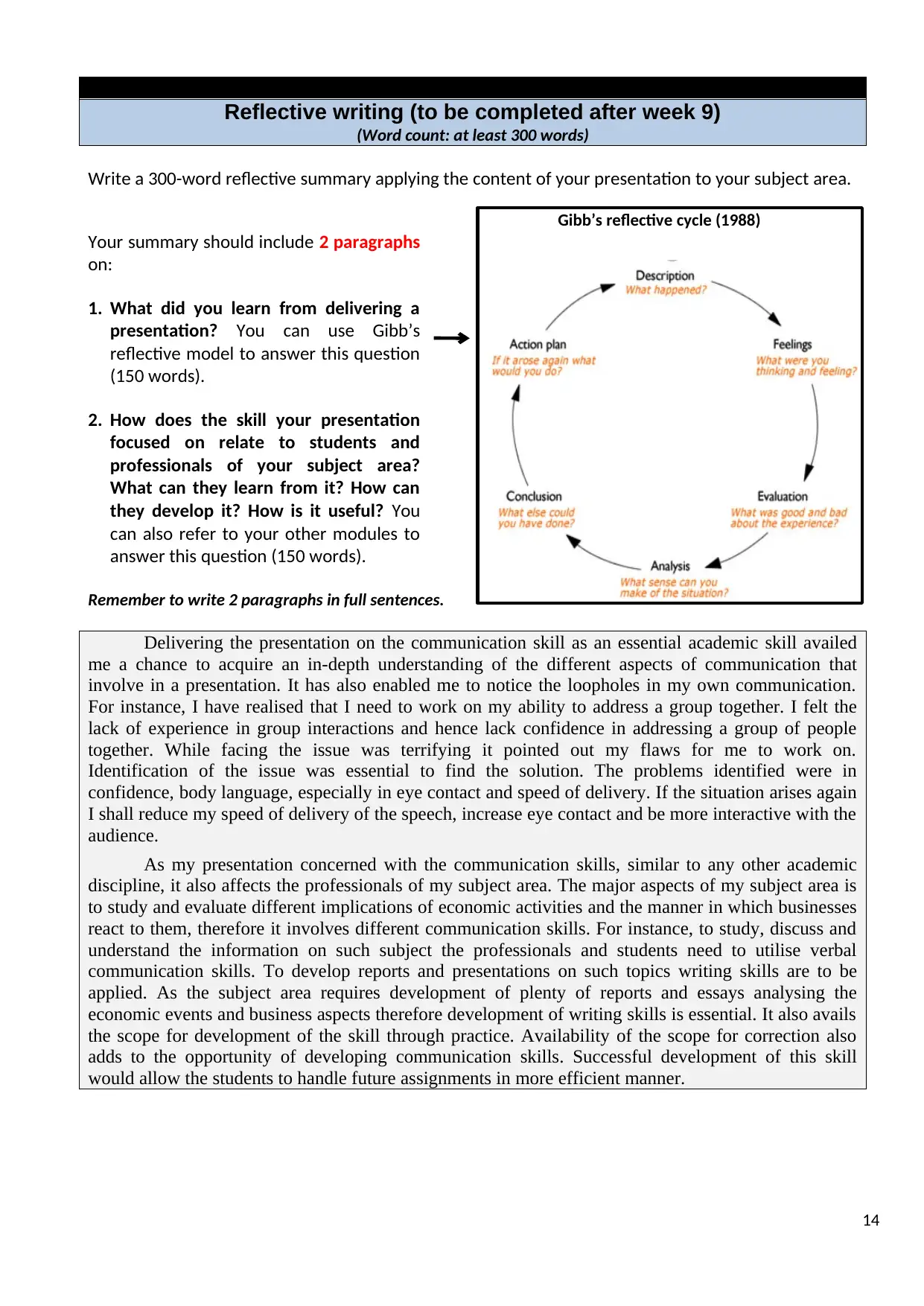
TASK 5
Reflective writing (to be completed after week 9)
(Word count: at least 300 words)
Write a 300-word reflective summary applying the content of your presentation to your subject area.
Your summary should include 2 paragraphs
on:
1. What did you learn from delivering a
presentation? You can use Gibb’s
reflective model to answer this question
(150 words).
2. How does the skill your presentation
focused on relate to students and
professionals of your subject area?
What can they learn from it? How can
they develop it? How is it useful? You
can also refer to your other modules to
answer this question (150 words).
Gibb’s reflective cycle (1988)
Remember to write 2 paragraphs in full sentences.
Delivering the presentation on the communication skill as an essential academic skill availed
me a chance to acquire an in-depth understanding of the different aspects of communication that
involve in a presentation. It has also enabled me to notice the loopholes in my own communication.
For instance, I have realised that I need to work on my ability to address a group together. I felt the
lack of experience in group interactions and hence lack confidence in addressing a group of people
together. While facing the issue was terrifying it pointed out my flaws for me to work on.
Identification of the issue was essential to find the solution. The problems identified were in
confidence, body language, especially in eye contact and speed of delivery. If the situation arises again
I shall reduce my speed of delivery of the speech, increase eye contact and be more interactive with the
audience.
As my presentation concerned with the communication skills, similar to any other academic
discipline, it also affects the professionals of my subject area. The major aspects of my subject area is
to study and evaluate different implications of economic activities and the manner in which businesses
react to them, therefore it involves different communication skills. For instance, to study, discuss and
understand the information on such subject the professionals and students need to utilise verbal
communication skills. To develop reports and presentations on such topics writing skills are to be
applied. As the subject area requires development of plenty of reports and essays analysing the
economic events and business aspects therefore development of writing skills is essential. It also avails
the scope for development of the skill through practice. Availability of the scope for correction also
adds to the opportunity of developing communication skills. Successful development of this skill
would allow the students to handle future assignments in more efficient manner.
14
Reflective writing (to be completed after week 9)
(Word count: at least 300 words)
Write a 300-word reflective summary applying the content of your presentation to your subject area.
Your summary should include 2 paragraphs
on:
1. What did you learn from delivering a
presentation? You can use Gibb’s
reflective model to answer this question
(150 words).
2. How does the skill your presentation
focused on relate to students and
professionals of your subject area?
What can they learn from it? How can
they develop it? How is it useful? You
can also refer to your other modules to
answer this question (150 words).
Gibb’s reflective cycle (1988)
Remember to write 2 paragraphs in full sentences.
Delivering the presentation on the communication skill as an essential academic skill availed
me a chance to acquire an in-depth understanding of the different aspects of communication that
involve in a presentation. It has also enabled me to notice the loopholes in my own communication.
For instance, I have realised that I need to work on my ability to address a group together. I felt the
lack of experience in group interactions and hence lack confidence in addressing a group of people
together. While facing the issue was terrifying it pointed out my flaws for me to work on.
Identification of the issue was essential to find the solution. The problems identified were in
confidence, body language, especially in eye contact and speed of delivery. If the situation arises again
I shall reduce my speed of delivery of the speech, increase eye contact and be more interactive with the
audience.
As my presentation concerned with the communication skills, similar to any other academic
discipline, it also affects the professionals of my subject area. The major aspects of my subject area is
to study and evaluate different implications of economic activities and the manner in which businesses
react to them, therefore it involves different communication skills. For instance, to study, discuss and
understand the information on such subject the professionals and students need to utilise verbal
communication skills. To develop reports and presentations on such topics writing skills are to be
applied. As the subject area requires development of plenty of reports and essays analysing the
economic events and business aspects therefore development of writing skills is essential. It also avails
the scope for development of the skill through practice. Availability of the scope for correction also
adds to the opportunity of developing communication skills. Successful development of this skill
would allow the students to handle future assignments in more efficient manner.
14
1 out of 14
Related Documents
Your All-in-One AI-Powered Toolkit for Academic Success.
+13062052269
info@desklib.com
Available 24*7 on WhatsApp / Email
![[object Object]](/_next/static/media/star-bottom.7253800d.svg)
Unlock your academic potential
© 2024 | Zucol Services PVT LTD | All rights reserved.



